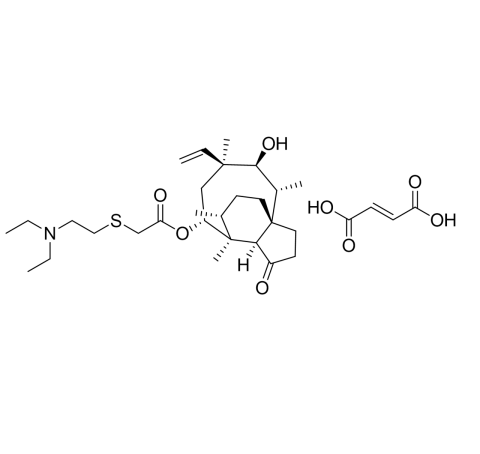Tiamulin is a semi-synthetic diterpene antibiotic used in veterinary medicine, primarily for swine and poultry, to treat bacterial infections like dysentery and respiratory diseases such as those caused by Mycoplasma. It works by inhibiting protein synthesis, and is effective both for treatment and prevention. However, tiamulin can cause severe interactions and even death if administered with certain ionophore anticoccidials like monensin, so it's crucial to use it responsibly and follow veterinary guidance for dosing and compatibility with other medications.
BRAND NAMES
Tiamulin is marketed under various veterinary brand names such as Denagard, Megagard, Stiagen-Vet, Tiavet Vet, Tiazin, TiaGard, and Trumulin. These medications contain Tiamulin Hydrogen Fumarate and are available in different forms and strengths, primarily for the treatment of respiratory and gastrointestinal infections in animals, especially swine and poultry.
MECHANISM OF ACTION
Tiamulin works by blocking the production of microbial proteins. It does this by binding to ribosomal RNA at the peptidyl-transferase center of the ribosome, where it interferes with the proper positioning of the CCA end of tRNA. This disruption prevents peptide transfer and ultimately halts the synthesis of specific proteins essential for bacterial growth.
PHARMACOKINETICS
Absorption:
When tiamulin is given orally to animals, it is quickly and efficiently absorbed; however, its bioavailability and peak blood concentrations are reduced because of significant first-pass metabolism in the liver. The drug spreads extensively throughout the body, with particularly high concentrations in the lungs and gastrointestinal tract, which makes it well-suited for treating respiratory and intestinal infections.
Distribution:
Tiamulin is widely distributed throughout the body after absorption, with particularly high concentrations found in the lungs, liver, kidneys, and gastrointestinal tract.
Metabolism:
Tiamulin is extensively metabolized in the liver following oral administration, primarily through oxidative processes involving the cytochrome P450 enzyme system. This first-pass metabolism reduces the amount of active drug reaching systemic circulation, thereby limiting its bioavailability. Despite this, therapeutic levels are still achieved in target tissues, particularly the lungs and gastrointestinal tract.
Excretion:
Although tiamulin plays a key role in promoting animal health and supporting food safety, its detection in water bodies has raised environmental concerns. Residues of tiamulin, excreted by treated animals, can make their way into waterways, where they may pose risks to aquatic ecosystems.
PHARMACODYNAMICS
Tiamulin is an antibiotic belonging to the pleuromutilin class, which exerts its pharmacodynamic effects by inhibiting bacterial protein synthesis. This primarily makes it a bacteriostatic agent, though it can become bactericidal at very high concentrations.
ADMINISTRATION
Tiamulin is administered orally, mainly through medicated feed or drinking water, primarily for swine and poultry. Dosage depends on the animal species and type of infection, and treatment should be guided by a veterinarian to ensure effectiveness and prevent resistance.
DOSAGE AND STRENGTH
Tiamulin is available in various formulations and strengths, commonly including 12.5% solution, 10% premix, and 80% soluble powder for veterinary use. The dosage of tiamulin varies depending on the species being treated, the type of infection, and the product formulation. For example, in swine, typical dosages range from 5 to 10 mg per kilogram of body weight per day, often administered through feed or water for several days. In poultry, dosages may vary but are usually adjusted to ensure effective treatment of respiratory and intestinal infections. Exact dosing should always follow veterinary guidance to ensure safety and effectiveness.
DRUG INTERACTIONS
Combining Tiamulin with Articaine may raise the risk or intensify the severity of methemoglobinemia. The therapeutic efficacy of BCG vaccine can be decreased when used in combination with Tiamulin. Methemoglobinemia may occur more frequently or severely when Tiamulin is combined with Benzocaine.
FOOD INTERACTIONS
The most critical food-related interaction for the veterinary antibiotic tiamulin is its deadly incompatibility with ionophore anticoccidial medications, which are often used as feed additives in farm animals like pigs and poultry. This interaction can result in severe illness and death.
CONTRAINDICATIONS
Swine receiving TiaGard 12.5% (tiamulin hydrogen fumarate) should not be given feed containing polyether ionophores such as monensin, lasalocid, narasin, salinomycin, or semduramicin, as this may lead to harmful reactions.
SIDE EFFECTS
As with all medications, the use of Tiamulin Injection may cause some unwanted side effects. Serious side effects may include:
• Fever
• Skin rash
• Facial Swelling
• Difficulty breathing
• Allergic reaction.
• depression or death when administered within 7 days of polyether ionophores.
OVER DOSE
• Loss of appetite
• Ataxia (loss of coordination)
• Lethargy or depression
• Vomiting or diarrhea
• Tremors or seizures (in severe cases)
• Liver damage or respiratory distress (rare but serious)
TOXICITY
Tiamulin, an antibiotic used in pigs and poultry, has a low risk of toxicity when administered alone. However, its toxicity increases significantly when co-administered with ionophore antibiotics such as monensin, salinomycin, narasin, and maduramicin. This dangerous drug interaction can cause severe and sometimes fatal health problems in livestock.







